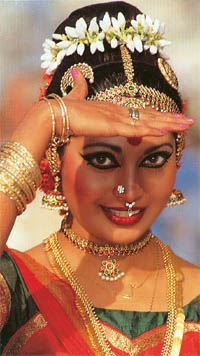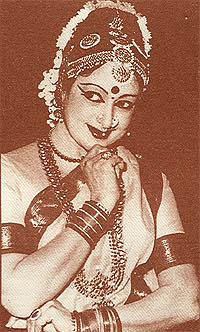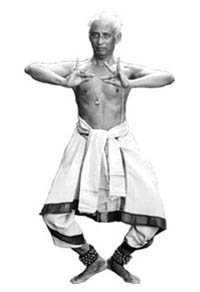In the Arms of the Lord of Dance
It was 40 degrees above zero scorching Indian heat. We, spectators were bathing
in sweat and sipping icy Pepsi. But the dancer after finishing two-hour
performance full of quick and impetuous jumps came up to us fresh as a lotus flower. For all that she was thickly made
up in a theatrical way and robed in magnificent garments, and the oil lamps were
burning on the stage where she danced.
jumps came up to us fresh as a lotus flower. For all that she was thickly made
up in a theatrical way and robed in magnificent garments, and the oil lamps were
burning on the stage where she danced.
-Aren't you hot? - I asked the temple dancer quite forgetting to make a
compliment to her art in amazement. However I little understood in a cascade of
strange bent poses in which she stood motionless like a statue, in swift finger
work taking shapes of complex figures and in the unusual playing of eyes.
-The thoughts about the heat would distract my mind from my thoughts of Shiva, -
a devadasi, a maidservant of deity answered mysteriously. - But now it is clear
to me that I had danced badly. If I danced the way my guru does you wouldn't
have been hot too.
Only later I knew the gift of a true devadasi is like that of yogis who are able
to melt snow and ice in Himalayas a few meters around them with the heat of
their bodies. The matter here is in the perfect work with psycho energy. But I
think that a classic dance even exceeds yoga. The yogi's aim is in
self-transformation. The aim of an Indian ritual dancer is by becoming a vessel
of divine energy also to lead viewers to the unity with the higher forces of the
Universe. It is not by mere accident that the final and at the same time the
culmination moment of dance is moksha, the deliverance from hardships of
existence and blending with the divine source. A dancer acts like a great
extrasensory person, a healer of body and soul illnesses. The amazing fact that
quite a lot of people who watch temple dance not only feel a special feeling of
pacification but also get rid of aches especially of psycho somatic nature is
explained by the mighty emanation that is coming from a dancer. Something
similar happens when a shaman performs his dance. Shamans are believed to be
obsessed by ghosts. But Lord Shiva Nataraja, the Lord of Dance enters the body
of an Indian dancer.
Almost everyone might have seen a figurine of four-handed Shiva in this position.
In his one hand he holds a drum, the image of the initial sound, rhythm,
vibration out of which the Cosmos sprung out. In his second hand he holds the
fire that destroys all that becomes obsolete. The gestures of two other hands
show that he will protect and save those who worship him. Dancing Shiva treads
under his feet a demon that embodies stagnation and passivity not letting him to
take possession of human souls. The god's dance is the symbol of the cosmic
movement and renovation. When he stops there will be the end of all days.
Shiva is not only the Lord; he is also a Yogishvara, a divine yogi. The two
incarnations of one god reflect the fundamental unity of two forms of meditation:
one being static yogi, the other is dynamic and is embodied in temple dance. A
dancer's deepest concentration on the meaning of gestures and poses rapidly
changing each other during the performance leads to the complete estrangement
from body. It starts to move as if by its own will without a slightest strain.
Both in yoga and dance a body is trained with the aim to completely forget about
it in the end, - explains an outstanding Indian dancer Padma Subramanyam. - It
is a means thanks to which the
 prevalence
of the corporal element in our consciousness is defeated. A dancer's ego
liberates itself from all the earthly by blending with the cosmic dance in which
the universe moves. The result of such dance is like that what yogi and priests
are aiming at by making sacrifices. Rest in the middle of movement is the
characteristic feature of basic figures in Indian dance and are called karanas.
A dancer's body keeps firmly fixed positions in the swiftest jumps. This
requires an extremely developed feeling of balance, ability for concentration
and breath control - pranayama that makes yoga and dance related. The
combination of statics and dynamics reveals the principles of Hindu world vision:
the male principle is the passive and contemplating consciousness; the female
principle is the active and world creating energy. It happens that a dancer
stays in one position for a long time, only her fingers and hands dance showing
the amazing flexibility and speed. The narration goes with the help of a
language of gestures called hastas and mudras. For instance, little fingers of
both hands fastened together signify intimacy, friendship, while joined index
fingers on the contrary signify enmity. Two palms put one over the other with
thumbs moved asides is the mudra "matsya", i.e. "a fish" one of Lord Vishnu's
reincarnations. If you see thumbs start moving that means the fish has started
to move. prevalence
of the corporal element in our consciousness is defeated. A dancer's ego
liberates itself from all the earthly by blending with the cosmic dance in which
the universe moves. The result of such dance is like that what yogi and priests
are aiming at by making sacrifices. Rest in the middle of movement is the
characteristic feature of basic figures in Indian dance and are called karanas.
A dancer's body keeps firmly fixed positions in the swiftest jumps. This
requires an extremely developed feeling of balance, ability for concentration
and breath control - pranayama that makes yoga and dance related. The
combination of statics and dynamics reveals the principles of Hindu world vision:
the male principle is the passive and contemplating consciousness; the female
principle is the active and world creating energy. It happens that a dancer
stays in one position for a long time, only her fingers and hands dance showing
the amazing flexibility and speed. The narration goes with the help of a
language of gestures called hastas and mudras. For instance, little fingers of
both hands fastened together signify intimacy, friendship, while joined index
fingers on the contrary signify enmity. Two palms put one over the other with
thumbs moved asides is the mudra "matsya", i.e. "a fish" one of Lord Vishnu's
reincarnations. If you see thumbs start moving that means the fish has started
to move.
The ancient Indian dance treatises tell about 28 positions for one hand and 24
positions for two hands. Hastas and mudras are mostly polysemantic; their
meaning is determined by the context. Thus a position called pataka (all fingers
are fastened together, the palm is open) can symbolize night, light, a river, a
horse, heat, opening or closing of a door, a street, equality, oath, an ideal
ruler, ocean waves, dream, praising. The execution of hastas and mudras has a
considerable psycho physical effect connected with the size of hand projection
upon cerebral cortex. This effect is well known to teachers and speech
therapists that use finger games to develop speech and quickness of wit in
children. Doctors see in hastas and mudras a stimulation of acupuncture points
on fingers, as a result a head becomes clearer and lighter. The Hindus believe
that hastas and mudras make Ajna-chakra, the third eye more active.
Another basic legs position is ardhamandali or semi-sitting position with knees
widely moved apart. This is a position of rest that relieves the nerve system. It can be
imagined as a combination of two triangles formed by a line mentally drawn
between knees. Here again you can see the symbol of male and female principles:
the triangle with its top down is the female principle, the triangle with its
top up is the male principle. In ardhamandali these two principles are balanced
that gives psychological and bioenergetics harmony.
apart. This is a position of rest that relieves the nerve system. It can be
imagined as a combination of two triangles formed by a line mentally drawn
between knees. Here again you can see the symbol of male and female principles:
the triangle with its top down is the female principle, the triangle with its
top up is the male principle. In ardhamandali these two principles are balanced
that gives psychological and bioenergetics harmony.
The combination of triangles also remains in other legs positions, for instance
on tiptoes position, when a dancer sits on toes with knees moved apart, and then
out of this position she puts them on the floor in turns or simultaneously.
The same principle of harmonization of male and female, of solar and lunar
energy lies at the basis of work with energy canals in hatha yoga. The word
hatha consists of a combination of two syllables: ha that signifies the Sun and
tha that signifies the Moon.
Generally, the possibilities of a spirit and body perfection found in Indian
classic dance are hardly inferior to those inherent with yoga. Dance has its
advantages in comparison with it. Quite a lot of people tried to practice asanas
but gave up the idea because of its tediousness. Just as many women could not
make themselves do physical exercises until aerobics and shaping appeared.
Padma Subramanyam disagrees that Indian classic dance requires a special inborn
body flexibility or exhausting daily trainings. According to her words "the
level of perfection in nritta (dance as it is without its subject component)
directly depends on extent of a dancer's perception of his/her own spiritual
essence and this has nothing to do with physique or even mastery". One fine day
the moment comes when dance itself in a mysterious way starts to lead a person
who sincerely desires to master it. Dance as if becomes an invisible
guru-instructor who gives body hints and helps it to stand in certain positions.
Anna Tkachova
| 